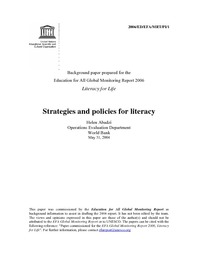| dc.contributor.author | Abadzi, Helen | |
| dc.date.accessioned | 2014-07-01T21:29:28Z | |
| dc.date.available | 2014-07-01T21:29:28Z | |
| dc.date.issued | 2004-05-31 | |
| dc.identifier.citation | “Paper commissioned for the EFA Global Monitoring Report 2006, Literacy for Life" | en_US |
| dc.identifier.uri | http://hdl.handle.net/10106/24328 | |
| dc.description.abstract | Executive Summary
Despite the existence of about one billion illiterates in the world, adult literacy programs
make up 1–5 percent of government or donor budgets, and they remain severely underfunded in
comparison to primary education. They have had a long and disappointing history of high dropout
and low achievement. Overall, many of the 1970s campaigns had efficiency rates of about 12.5
percent, with few participants acquiring stable literacy skills.
The 1990s brought new strategies that included empowering NGOs and focusing on
existing groups and on management improvement for governments and cooperating
organizations. The numbers of participants increased, while dropout and course completion rates
improved as a result of increased attention to management,. However the outcomes of literacy
instruction are still modest and may have improved little since the 1970s. Social benefits are also
uncertain. | en_US |
| dc.description.sponsorship | Education for All Global Monitoring Report | en_US |
| dc.language.iso | en_US | en_US |
| dc.publisher | UNESCO | en_US |
| dc.relation.ispartofseries | Background paper for the Education for all global monitoring report 2006: literacy for life;2006/ED/EFA/MRT/PI/1 | |
| dc.subject | Literacy | en_US |
| dc.subject | Adult literacy | en_US |
| dc.subject | Educational strategies | en_US |
| dc.subject | Educational policy | en_US |
| dc.title | Strategies and policies for literacy | en_US |
| dc.type | Working Paper | en_US |
| dc.identifier.externalLink | http://www.unesco.org/ulis/cgi-bin/ulis.pl?catno=145933&set=53B324DB_2_21&gp=1&lin=1&ll=1 | en_US |

